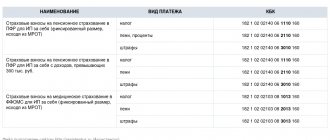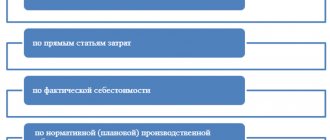What is KBK in a payment order?
The budget classification code in the payment slip is a special digital code that should indicate budget income and expenses.
An organization's accounting department encounters these codes when it makes a payment to the budget system, but most often does not understand what this sequence of numbers is and what it means in the payment order. What KBK and payment cards are available from January 1, 2020 can be viewed on this page - the classifier contains up-to-date information. But to understand the structure of the code, let's take a closer look at it. Let's look at what the KBK consists of, how important it is to indicate it correctly on the payment slip, and what to do with errors. The decoding is given in Order of the Ministry of Finance of the Russian Federation dated July 1, 2013 No. 65n. In accordance with it, the BCC indicated in payment orders consists of 20 digits combined into groups. Each group has its own meaning.
KBK is .
Taxpayers (organizations and individuals) replenish the budget when they pay legally established taxes. The government's fiscal policy consists of manipulating taxes and government spending. To classify financial flows for the purpose of managing them, the KBK is used.
So, KBK is a code. It encrypts the purpose of funds received by the budget and, accordingly, expenses incurred.
Budget revenues are accounted for separately in accordance with the KBK and OKATO (classifier of objects of administrative-territorial division). Using the code, you can track the path of any amount included in the budget: from which region and which organization the payment was made. On what basis and where was it redirected? In this way, state control is exercised over the receipt of taxes and fees in controlled territories, statistical information on budget flows by economic sectors is collected and processed.
Obviously, different taxes and fees, as well as penalties and fines for them, have different BCCs. But the system of budget classification codes is the same throughout the country.
Conventionally, budget classification codes can be divided into four large blocks:
- budget expenses;
- budget revenues;
- sources of financing;
- sources for reducing the budget deficit.
What does the budget classification code consist of?
Each digit of the code indicated on the payment slip is also called a digit. The digits are combined into blocks as follows:
The first group is administrative. It consists of three digits and reflects the code of the chief revenue administrator. For example, the Federal Tax Service code in the payment order is 182; FSS code in the payment slip is 393.
The second block is profitable. It includes several information messages at once. The first of them (bit 4) is expressed in one digit and indicates the type of payment received. For example, the number 1 means that it came in the form of a tax, 2 - that it came in the form of gratuitous income, 3 - from business, etc.
Next comes a subgroup. These are two signs that indicate for what purpose the cash receipts from the payment order are intended. So, 01 - profit tax and income tax; 02 - tax or fee for social needs, 08 - state duty.
The table will help when filling out a payment order. It contains a detailed decoding of the KBK, the categories are indicated in a separate column.
| KBK structure | Category No. | What to indicate in a payment order |
| Income group | 4 |
|
| Income subgroup | 5, 6 | For tax and non-tax income:
|
The third block also includes a group and a subgroup (two and three numbers in a row, respectively).
The next element in the payment order defines the budget code and consists of two digits, designated as follows:
- 01 - federal;
- 02 - subject of the Federation;
- 03 - local, etc.
| KBK structure | Category No. | What to indicate in a payment order |
| Income item | 7 | Codes by which administrators classify incoming payments. The codes are indicated in Appendix 1.1 to the Directives approved by Order of the Ministry of Finance of Russia dated July 1, 2013 No. 65n. |
| 8 | ||
| Sub-item of income | 9 | |
| 10 | ||
| 11 | ||
| Income element | 12,13 | Codes for distribution of payments - budgets:
|
Next are 4 key numbers that determine the “reason” for the payment (digit numbers in the BCC are 14, 15, 16, 17). It is important to understand here that there can be only three reasons:
- payment of the tax itself (fee, contribution);
- payment of penalties on it;
- payment of a fine thereunder.
So, for example, at the time of writing, when filling out payment orders, the following designations are generally accepted: payment - 1000, 2100 - penalties, 3000 - fine. For example:
- 182 1 0100 110 - when paying personal income tax to the budget;
- 182 1 0100 110 - upon payment of penalties for personal income tax;
- 182 1 0100 110 - payment of a fine.
And finally, the last three digits of any code are a classifier of the type of income (tax, non-tax, from property, etc.). For example, 010 is tax income; 130—receipts from the provision of paid services, work and compensation of costs; 150 - gratuitous receipts from budgets.
| KBK structure | Category No. | What to indicate in a payment order |
| Analytical group of budget income subtype | 18, 19, 20 | The values of the codes are approved by the Ministry of Finance of Russia, the financial body of the subject of the Russian Federation, municipal formation. If not approved, please indicate:
Items of disposal of non-financial assets:
|
KBK structure
KBK consists of twenty digits, divided into categories.
| Budget income subtype code | |||||||||||||||||||
| income group | income item | income element | analytical group of budget revenue subtype | ||||||||||||||||
| 1 | 2 | 3 | 4 | 5 | 6 | 7 | 8 | 9 | 10 | 11 | 12 | 13 | 14 | 15 | 16 | 17 | 18 | 19 | 20 |
- 1-3
manager of funds (for example, 182 - Federal Tax Service, 392 - Pension Fund, 393 - Social Insurance Fund); - 4-6
tax or contribution code (group 100 – taxes, fees, fines, sanctions; group 200 – gratuitous receipts); - 7, 8
budget level (01 – federal budget; 02 – subject budget; 03 – budgets of federal cities); - 14-17
type of payment (1000 – tax, contribution or arrears; 2100 – penalties, 3000 – fine); - 18-20
economic type of income (110 – taxes; 130 – provision of services).
- 182 – the tax office manages the money;
- 101 – according to the current classification of income, this is income tax;
- 01 – funds went to the federal budget;
- 1000 – tax fee;
- 110 – tax.
To find a decoding of a specific budget classification code, follow the link
, press F3 or Ctrl+F. After clicking, a search bar will appear below the toolbar. Enter the 20-digit KBK you are looking for, without spaces, and see its decoding in the left column of the table.
KBK field in a payment order
Each field in the payment order is assigned its own number.
The payment order has a separate field for KBK (this is the 104th field), and it must be filled out correctly (you can see the rules for filling out a payment order in the “Regulations on the rules for transferring funds” (approved by the Bank of Russia on June 19, 2012 No. 383-P If the BCC is indicated incorrectly on the payment slip, then the corresponding amount may be classified as unexplained payments. The Federal Treasury may classify it as “unclarified.” At the same time, an error in indicating the BCC on the payment slip can lead to arrears in taxes and insurance premiums.
Here is an example of a completed payment slip with entered data about the recipient:
- field 104 of the payment order indicates the KBK for transferring personal income tax;
- 105 - OKTMO;
- 106 - basis - current payment (abbreviated as TP);
- 107 - period (MS - abbreviated month);
- 108 - this field contains “0” (when paying on demand, the number of the document with the demand is entered in this field of the payment order);
- 109 - “0” (the payment field is intended to indicate the date of submission of the declaration or settlement. If the payment is made regardless of the submission of reports, “0” is always placed in this payment field);
- 110 - the field always remains empty in the payment order;
- 24 - brief purpose of payment: type of tax and payment period.
IMPORTANT!
In 2020, insurance premiums must be paid not to the funds, but to the tax inspectorates; accordingly, other account details are indicated in the payment slips. Payment of contributions for “injuries” is also transferred to the Social Insurance Fund.
Kbk code: what is it in the details and where to get it
Taxpayers in the course of their activities are required to contribute funds to the state treasury. When transferring, one of the required details is KBK.
How to find out the budget classification code? What is its essence? What is this clever prop for? We will consider these and other questions in this article. A little history The budget classification code was established in 1999.
Of course, since that time the code book has changed more than once. How to find out the budget classification code? Key codes are located at the beginning of the directory. This is the revenue part for posting tax payments, contributions, state duties and excise taxes. Many felt that the introduction of codes no longer made work easier, but rather made it more difficult. Frequently changing the encoding presented some inconvenience, and the accountant could mistakenly send a payment to the wrong budget. Accordingly, for this organization the payment was not taken into account and a debt arose. How to find out KBK Looking at the KBK reference book and how it is deciphered, it can be noted that the codes are available in special documentation; this document contains the necessary data that corresponds to a particular payment. Sometimes there are changes in documentation that require special attention.
The list of codes, which is currently relevant, has been approved by the Council of Ministers of the country. Individual entrepreneurs and legal entities are required to know these codes in order to competently and efficiently fill out specialized orders for tax payments.
This also applies to making payments on contributions and other payments to extra-budgetary funds. In payment documents, this code is indicated in field No. 104.
This detail can be useful in determining the types of reporting documents. The question arises: are the income code and the KBK the same thing? There is no definite answer, since everything depends on the specific situation.
If the KBK is incorrectly indicated on the payment, what to do?
The payer may receive a payment with an incorrect BCC. For example, KBK 392 1 1600 140 is indicated, how to fill out a payment order (2018) using this code? There is only one answer: there is no need to fill out such a payment form, since this code is no longer used. Previously, fines were paid to the Pension Fund of the Russian Federation using this code for late submission of reports on insurance premiums. Now tax accounting in the Pension Fund of Russia is administered by the Federal Tax Service, so the old KBK has lost its relevance. But if a mistake has already been made, you incorrectly indicated the KBK in the payment order and transferred money, then proceed as follows.
Step 1. An application must be sent to the tax office or the territorial branch of an extra-budgetary fund to clarify the details of the payment order. The application is written in any form. Please attach a copy of the payment slip with the bank's stamp to your application.
Step 2. Tax inspectors must make a decision on the issue of clarifying payment within 10 working days. This period begins to count from the date of application, when the inspectors received your application for clarification of payment, or from the date of signing (registration) of the act of joint reconciliation of calculations (if it was carried out).
Step 3. After the deadline has expired, be sure to order a tax certificate of settlements with the budget or a reconciliation report to make sure that the inspectors credited the amount to the correct BCC.
Since the KBK belongs to the group of details that allow one to determine the identity of the payment, if an erroneously specified KBK is detected in the order for the transfer of tax, the payer has the right to contact the tax authority with an application to clarify the identity of the payment. This position has been repeatedly expressed by the Ministry of Finance (for example, Letter dated January 19, 2017 No. 03-02-07/1/2145).
What are the consequences of an error in the KBK?
If the payment purpose code is specified incorrectly, the payment will be transferred to the budget, but it will not be distributed correctly there, which means that the state will not actually receive it. The result may be the same as if the money had not been transferred at all: the tax office will count the arrears under a certain item. At the same time, if the BCC is simply mixed up, there may be an overpayment under another item.
As a result, the tax office will issue a demand for payment of arrears, a fine for late payment of tax or a fee and penalties for late payment. This situation is extremely unpleasant for a conscientious entrepreneur who paid the tax on time, whose entire fault lies in confusion with numerous CBCs.
The usual procedure for an entrepreneur when an error is detected in the KBK
- The most important thing is to make sure that the error did not lead to non-receipt of income to the budget, otherwise it will be considered that the funds were not paid, with the payer being fully responsible for this.
- Submit to your tax accounting office a statement about the detected error and a request to clarify the basis, type and affiliation of the transfer of funds, if necessary, the tax period or tax payer status.
- The application must be accompanied by payment orders for which the tax was paid and received by the budget.
- If necessary, a reconciliation of paid taxes is carried out jointly with the inspector (a report is drawn up about it).
- After a few days (the period is not defined by law), a decision is made to clarify this payment and is handed over to the applicant.
IMPORTANT! When a payment is clarified, it is considered completed on the day the payment order is submitted with an incorrect BCC, and not on the day the decision on clarification and offset is received. Thus, the delay in mandatory payment, which provides for penalties, does not actually occur.
Let's look at various cases that occur due to errors in the CBC and analyze what an entrepreneur should do.
- The inspectorate assessed penalties for non-payment of taxes . If there was a beneficial request from the payer to offset the amount paid, then you should additionally ask the tax office to recalculate the accrued penalties. If the tax office refuses to do this, going to court will most likely allow for a recalculation (there is a rich case law with similar precedents).
- The BCC does not correspond to the payment specified in the assignment . If the error is “within one tax”, for example, the KBK is indicated on the USN-6, and the payment basis is indicated on the USN-15, then the tax office usually easily makes a re-offset. If the KBK does not completely correspond to the basis of the payment, for example, a businessman was going to pay personal income tax, but indicated the KBK belonging to the VAT, the tax office often refuses to clarify, but the court is almost always on the side of the taxpayer.
- Due to an error in the KBK, insurance premiums were unpaid . If the funds do not reach the required treasury account, this is almost inevitably fraught with fines and penalties. The entrepreneur should repeat the payment as quickly as possible with the correct details in order to reduce the amount of possible penalties. Then the money paid by mistake must be returned (you can also count it against future payments). To do this, an application is sent to the authority to whose account the money was transferred erroneously. Failure to comply with a request for a refund or re-credit is a reason to go to court.
- The funds entered the planned fund, but under the wrong heading . For example, the payment slip indicated the KBK for the funded portion of the pension, but they intended to pay for the insurance portion. In such cases, contributions are still considered to have been made on time, and you must proceed in the same way as under the usual procedure. The court can help with any problems with a fund that refuses to make a recalculation, and an illegal demand for payment of arrears and the accrual of penalties.
REMEMBER! According to the law, an error in the KBK is not a reason for which the payment will not be considered transferred. The payment order contains additional information indicating the purpose of the payment and its recipient, therefore, if it is indicated correctly, there is and cannot be a reason for penalties against the entrepreneur; other decisions can be challenged in court.
Articles on the topic
The budget classification code is an integral requisite when transferring funds to the budget. Obviously, the sequence of 20 numbers is a kind of cipher. In this article we will look at what a KBK is, why it is needed and why it is important to avoid making mistakes when specifying the code.
Table of frequently used BCCs
| BCC for personal income tax (NDFL) | KBK on single income tax with simplification |
| KBK for land tax | KBK for payment of a single tax with a simplification of the difference between income and expenses |
| KBK for corporate property tax | KBK on water tax |
| KBK for the single tax on imputed income (UTII) | KBK for VAT 2020 |
| KBK for income tax | KBC for insurance premiums for 2020: pension, medical, social insurance |
| KBK on transport tax for legal entities and citizens | KBK for payment of income tax credited to the budgets of constituent entities of the Russian Federation |
How to find out the KBK code?
You can find out the sequence of writing the numbers of the required code:
- in a special directory;
- on the website of the relevant government agency - Federal Tax Service, etc.;
- at the tax office;
- in the order of the Ministry of Finance of the Russian Federation No. 65n.
A 20-digit entry requires extreme care, so you should not fill out the necessary KBK payment details from memory.
An error in writing even one number will divert funds to another part of the budget or leave them as unidentified payments. Ultimately, arrears may arise on mandatory government payments and penalties will follow.
If you make a mistake in writing the details, you need to urgently take measures to find the incorrectly sent payment. Then write a request for a refund. If the tax codes on your payment slip are mixed up, you can contact the tax service with a request to offset payments.
How to correctly indicate BCC in settlement documents
The form of the payment order and the procedure for filling out the transfer of obligatory payments to the budget are approved by the Directive of the Central Bank of the Russian Federation dated 03.03.2003 No. 1256-U, and the rules for filling out are approved by the Ministry of Taxes of the Russian Federation dated 03.03.2003 No. BG-3-10/98. In 2020, the payment order forms established by the Regulation of the Central Bank of the Russian Federation No. 383-P and Order of the Ministry of Finance dated November 12, 2013 No. 107n are used.
Each field of the order has its own code, with the help of which the Central Bank and the Ministry of Finance establish the rules for filling out the details. For example, field 101 is for payer status.
IMPORTANT!
The KBK field in the payment order is field 104.
Adviсe
You always need to write codes accurately, without errors. Of course, sometimes there are mistakes in writing numbers, but they must be eliminated. Because the Ministry of Finance clarified that payments using incorrect details will still go through. And the government agency to which the payment was never received due to an error will charge interest for late payment. Of course, this situation is not very fair, however, at the moment the situation is this way.
With the management of the CBC, it is easier to pay for services, because it is not necessary to go to the organization’s office. All you need to do is find an ATM or pay through your online account at home. It is more convenient because people save time. It is necessary to understand the meaning of its introduction in order to know what the budget classification code is. And it is easier for regulatory organizations to track cash flows.
Thus, having studied the information about the budget classification code, you can easily pay various bills of government agencies. Because now you know where to find it if it's not on your pay stub. To summarize, it is worth answering the question of what is the BCC on the receipt. These are encrypted numbers necessary for the correct crediting of funds.
Meaning
Now it becomes clear what a budget classification code is, and it is necessary to explain how important it is when paying.
KBK is considered a generally accepted requisite for making payments to various government bodies. Transfers can be made at banks with a payment order in hand.
This code is needed to:
- quickly create budgets at different levels;
- it is easy to verify the implementation of decisions of regional entities;
- increase the level of reporting;
- carry out accounting of the revenue component of budgets.
Without a code, not a single payment transaction is simply possible. The convenience lies in the fact that you do not need to go to the organization. You can pay for services at home using your computer.









